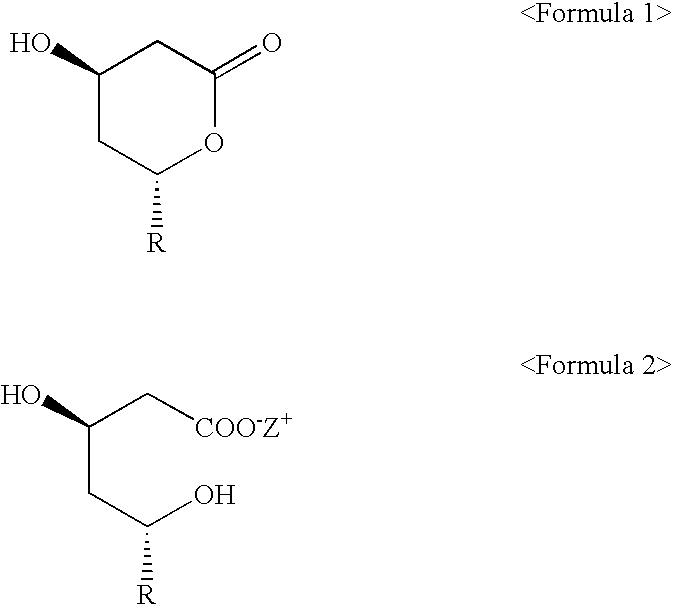Process of lactonization in the preparation of statins
a statin and lactonization technology, applied in the field of statin preparation, can solve the problems of large quantity, disadvantageous to the reaction efficiency, not very palatable, etc., and achieve the effect of reducing the disadvantage of stability
- Summary
- Abstract
- Description
- Claims
- Application Information
AI Technical Summary
Benefits of technology
Problems solved by technology
Method used
Image
Examples
example 1
Preparation of 6(R)-[2-[8(S)-(2,2-dimethylbutylyloxy)-2(S), 6(R)-dimethyl-1,2,6,7,8,8a(R)-hexahydronaphthyl]-1(S)ethyl]-hydroxy-3,4,5,6-tetrahydro-2H-pyrane-2-one (simvastatin)
Ammonium 7-[1,2,6,7,8,8a(R)-hexahydro-2(S), 6(R)-dimethyl-8(S)-(2,2-dimethylbutylyloxy)-1(S)-naphthyl]-3 (R), 5(R)-dihydroxyheptanoate (2.42 g, 5.3 mmoles) was refluxed under nitrogen sweep at 100.about.110.degree. C. for 3 hours with a mixture of toluene (49 ml) and magnesium sulfate (0.48 g, 4.0 mmoles). Then, the reaction mixture was cooled to 25.degree. C. and 2.4 g of activated charcoal was added. Then, the reacted product was stirred for 30 minutes then, filtrated and distilled under a reduced pressure for toluene so as to be adjusted to have 5 ml volume. Afterward, 50 ml of cyclohexane was added to the remained product and heated to 35.degree. C. and stirred for 3 hours. The crystals formed above was filtrated, washed using about 20 ml of toluene / cyclohexane (1:10 (v / v)) and dried under vacuum at 40.deg...
example 2
Preparation of 6(R)-[2-[8(S)-(2,2-dimethylbutylyloxy)-2(S),6(R)-dimethyl-1,2,6,7,8,8a(R)-hexahydronaphthyl]-1(S)ethyl]-4(R)-hydroxy-3,4,5,6-tetra hydro-2H-pyrane-2-one (simvastatin)
Ammonium 7-[1,2,6,7,8,8a(R)-hexahydro-2(S),6(R)-dimethyl-8(S)-(2,2-dimethylbutylyloxy)-1(S)-naphthyl]-3(R),5(R)-dihydroxyheptanoate (2.42 g, 5.3 mmoles) was refluxed under nitrogen sweep at 100.about.110.degree. C. for 3 hours with a mixture of toluene (49 ml) and magnesium sulfate (0.48 g, 4.0 mmoles). Then, the reaction mixture was cooled to 25.degree. C. and 2.4 g of activated charcoal was added. Then, the reacted product was stirred for 30 minutes, filtrated and distilled under a reduced pressure. Afterward, 21.2 ml of ethanol was added to the remained product and heated to 40.degree. C. Then, 21.2 ml of water was added dropwisely and stirred for 30 minutes. In case that crystal was made, the resulting solution was cooled to 4.degree. C. and stirred for 2 hours. The crystals formed above was filtrated...
example 3
Preparation of 6(R)-[2-[8(S)-(2-methylbutylyloxy)-2(S),6(R)-dimethyl-1,2,6,7,8,8a(R)-hexahydronaphthyl]-1(S)ethyl]-4(R)-hydroxy-3,4,5,6-tetra hydro-2H-pyrane-2-one (lovastatin).
Excepting using of ammonium 7-[1,2,6,7,8,8a(R)-hexahydro-2(S),6(R)-dimethyl-8(S)-(2-methylbutylyloxy)-1(S)-naphthyl]-3(R),5(R)-dihydroxyheptanoate as a starting material, the same procedure as described in Example 1 were repeated. As a result, 2.05 g (yield: 92%) of 6(R)-[2-[8(S)-(2-methylbutylyloxy)-2(S),6(R)-dimethyl-1,2,6,7,8,8a(R)-hexahydronaphthyl]-1(S)ethyl]-4(R)-hydroxy-3,4,5,6-tetrahydro-2H-pyrane-2-one (lovastatin) was obtained in 98.3% purity (HPLC). The amount of heterodimers reached 0.16%.
PUM
| Property | Measurement | Unit |
|---|---|---|
| time | aaaaa | aaaaa |
| reaction time | aaaaa | aaaaa |
| reaction time | aaaaa | aaaaa |
Abstract
Description
Claims
Application Information
 Login to View More
Login to View More - R&D
- Intellectual Property
- Life Sciences
- Materials
- Tech Scout
- Unparalleled Data Quality
- Higher Quality Content
- 60% Fewer Hallucinations
Browse by: Latest US Patents, China's latest patents, Technical Efficacy Thesaurus, Application Domain, Technology Topic, Popular Technical Reports.
© 2025 PatSnap. All rights reserved.Legal|Privacy policy|Modern Slavery Act Transparency Statement|Sitemap|About US| Contact US: help@patsnap.com



